Bachelor of Applied Management: Economics Assignment Solution
VerifiedAdded on 2023/01/23
|15
|2858
|78
Homework Assignment
AI Summary
This economics assignment explores core concepts in business decision-making and market structures. It begins by analyzing cost structures (total, average, and marginal) and their relationships, using tables and graphs to illustrate concepts such as average fixed cost, average variable cost, and marginal cost. The assignment then delves into market structures, identifying and characterizing monopolistically competitive, oligopolistic, and monopoly markets through real-world examples like convenience stores, ASB bank, and Auckland Airport. The next section examines how firms in perfectly competitive markets make production decisions based on market price, marginal cost, and average cost, including shut-down points. The assignment also includes a comparison of airline pricing strategies. Finally, the assignment evaluates the role of government in addressing market failures, particularly in the context of positive externalities (education) and the equity-efficiency trade-off, using examples such as government subsidies for education and minimum wage policies.

Running head: BACHELOR OF APPLIED MANAGEMENT
Bachelor of Applied Management
Name of the Student
Name of the University
Course ID
Bachelor of Applied Management
Name of the Student
Name of the University
Course ID
Paraphrase This Document
Need a fresh take? Get an instant paraphrase of this document with our AI Paraphraser

1BACHELOR OF APPLIED MANAGEMENT
Table of Contents
Section A: Business Decision Making.......................................................................................2
Question 1..............................................................................................................................2
Question 2..............................................................................................................................3
Question 3..............................................................................................................................5
Question 4..............................................................................................................................7
Section B: The role of Government in markets.........................................................................8
Question 1..............................................................................................................................8
Question 2............................................................................................................................10
References................................................................................................................................13
Table of Contents
Section A: Business Decision Making.......................................................................................2
Question 1..............................................................................................................................2
Question 2..............................................................................................................................3
Question 3..............................................................................................................................5
Question 4..............................................................................................................................7
Section B: The role of Government in markets.........................................................................8
Question 1..............................................................................................................................8
Question 2............................................................................................................................10
References................................................................................................................................13
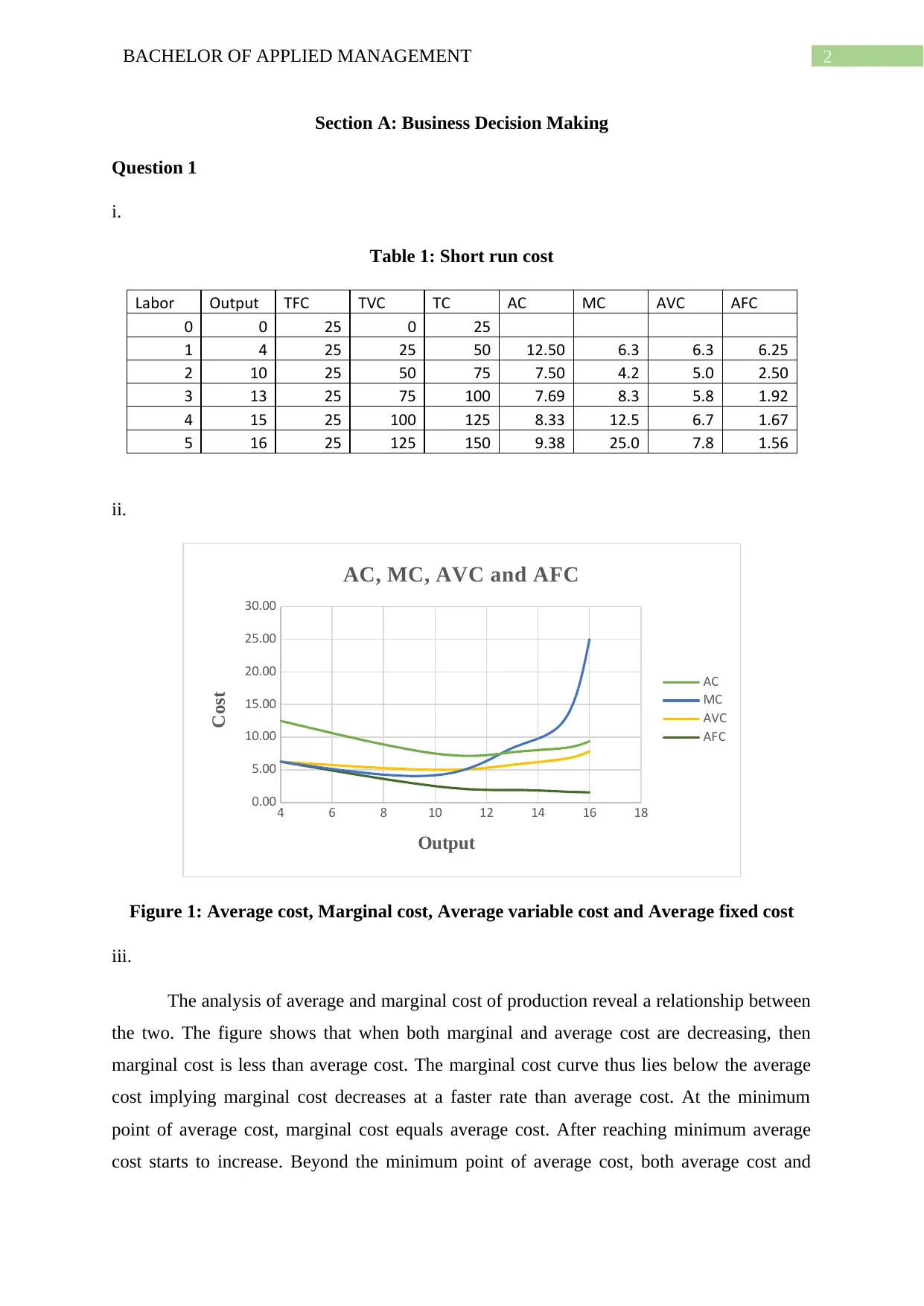
2BACHELOR OF APPLIED MANAGEMENT
Section A: Business Decision Making
Question 1
i.
Table 1: Short run cost
Labor Output TFC TVC TC AC MC AVC AFC
0 0 25 0 25
1 4 25 25 50 12.50 6.3 6.3 6.25
2 10 25 50 75 7.50 4.2 5.0 2.50
3 13 25 75 100 7.69 8.3 5.8 1.92
4 15 25 100 125 8.33 12.5 6.7 1.67
5 16 25 125 150 9.38 25.0 7.8 1.56
ii.
4 6 8 10 12 14 16 18
0.00
5.00
10.00
15.00
20.00
25.00
30.00
AC, MC, AVC and AFC
AC
MC
AVC
AFC
Output
Cost
Figure 1: Average cost, Marginal cost, Average variable cost and Average fixed cost
iii.
The analysis of average and marginal cost of production reveal a relationship between
the two. The figure shows that when both marginal and average cost are decreasing, then
marginal cost is less than average cost. The marginal cost curve thus lies below the average
cost implying marginal cost decreases at a faster rate than average cost. At the minimum
point of average cost, marginal cost equals average cost. After reaching minimum average
cost starts to increase. Beyond the minimum point of average cost, both average cost and
Section A: Business Decision Making
Question 1
i.
Table 1: Short run cost
Labor Output TFC TVC TC AC MC AVC AFC
0 0 25 0 25
1 4 25 25 50 12.50 6.3 6.3 6.25
2 10 25 50 75 7.50 4.2 5.0 2.50
3 13 25 75 100 7.69 8.3 5.8 1.92
4 15 25 100 125 8.33 12.5 6.7 1.67
5 16 25 125 150 9.38 25.0 7.8 1.56
ii.
4 6 8 10 12 14 16 18
0.00
5.00
10.00
15.00
20.00
25.00
30.00
AC, MC, AVC and AFC
AC
MC
AVC
AFC
Output
Cost
Figure 1: Average cost, Marginal cost, Average variable cost and Average fixed cost
iii.
The analysis of average and marginal cost of production reveal a relationship between
the two. The figure shows that when both marginal and average cost are decreasing, then
marginal cost is less than average cost. The marginal cost curve thus lies below the average
cost implying marginal cost decreases at a faster rate than average cost. At the minimum
point of average cost, marginal cost equals average cost. After reaching minimum average
cost starts to increase. Beyond the minimum point of average cost, both average cost and
⊘ This is a preview!⊘
Do you want full access?
Subscribe today to unlock all pages.

Trusted by 1+ million students worldwide
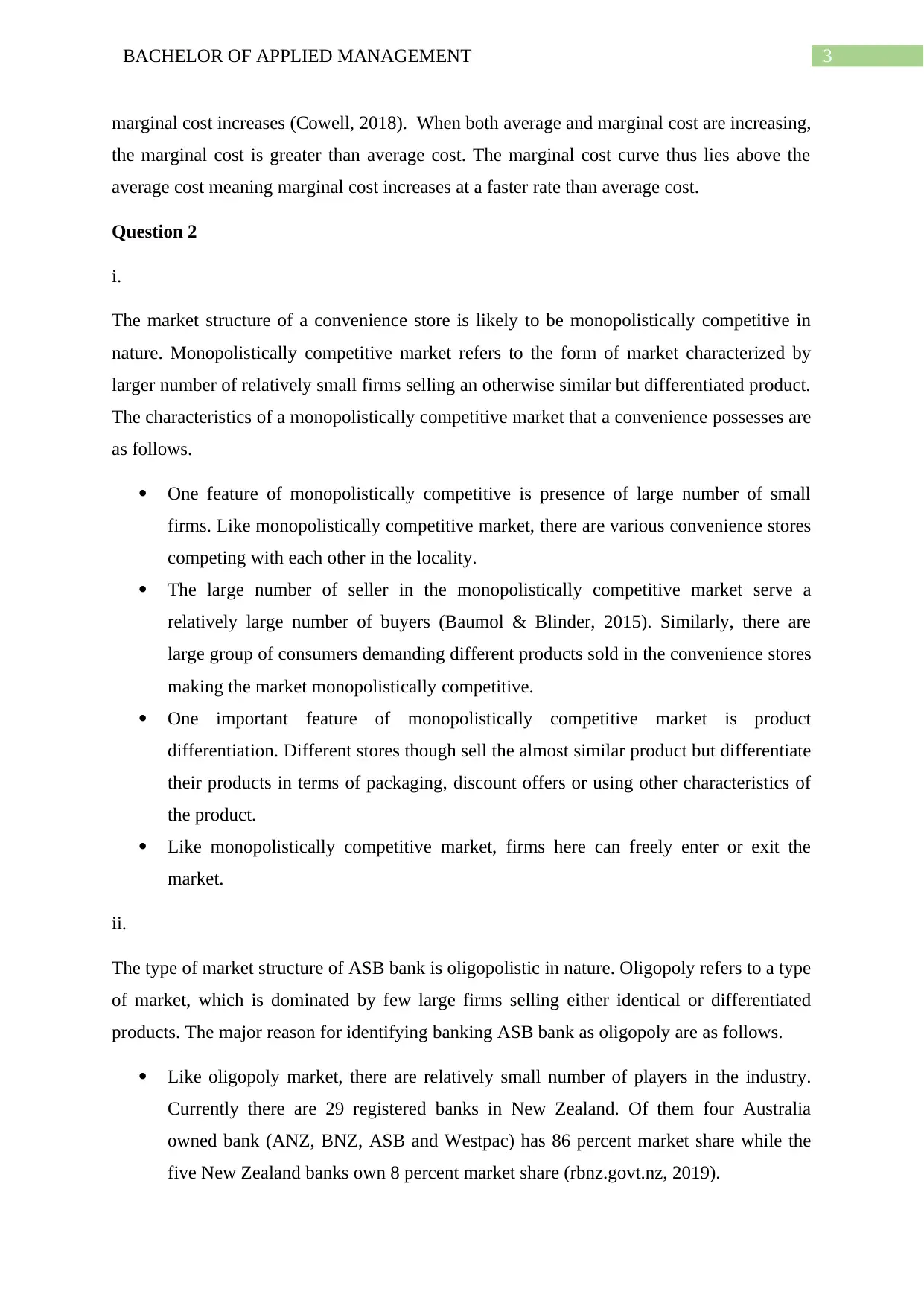
3BACHELOR OF APPLIED MANAGEMENT
marginal cost increases (Cowell, 2018). When both average and marginal cost are increasing,
the marginal cost is greater than average cost. The marginal cost curve thus lies above the
average cost meaning marginal cost increases at a faster rate than average cost.
Question 2
i.
The market structure of a convenience store is likely to be monopolistically competitive in
nature. Monopolistically competitive market refers to the form of market characterized by
larger number of relatively small firms selling an otherwise similar but differentiated product.
The characteristics of a monopolistically competitive market that a convenience possesses are
as follows.
One feature of monopolistically competitive is presence of large number of small
firms. Like monopolistically competitive market, there are various convenience stores
competing with each other in the locality.
The large number of seller in the monopolistically competitive market serve a
relatively large number of buyers (Baumol & Blinder, 2015). Similarly, there are
large group of consumers demanding different products sold in the convenience stores
making the market monopolistically competitive.
One important feature of monopolistically competitive market is product
differentiation. Different stores though sell the almost similar product but differentiate
their products in terms of packaging, discount offers or using other characteristics of
the product.
Like monopolistically competitive market, firms here can freely enter or exit the
market.
ii.
The type of market structure of ASB bank is oligopolistic in nature. Oligopoly refers to a type
of market, which is dominated by few large firms selling either identical or differentiated
products. The major reason for identifying banking ASB bank as oligopoly are as follows.
Like oligopoly market, there are relatively small number of players in the industry.
Currently there are 29 registered banks in New Zealand. Of them four Australia
owned bank (ANZ, BNZ, ASB and Westpac) has 86 percent market share while the
five New Zealand banks own 8 percent market share (rbnz.govt.nz, 2019).
marginal cost increases (Cowell, 2018). When both average and marginal cost are increasing,
the marginal cost is greater than average cost. The marginal cost curve thus lies above the
average cost meaning marginal cost increases at a faster rate than average cost.
Question 2
i.
The market structure of a convenience store is likely to be monopolistically competitive in
nature. Monopolistically competitive market refers to the form of market characterized by
larger number of relatively small firms selling an otherwise similar but differentiated product.
The characteristics of a monopolistically competitive market that a convenience possesses are
as follows.
One feature of monopolistically competitive is presence of large number of small
firms. Like monopolistically competitive market, there are various convenience stores
competing with each other in the locality.
The large number of seller in the monopolistically competitive market serve a
relatively large number of buyers (Baumol & Blinder, 2015). Similarly, there are
large group of consumers demanding different products sold in the convenience stores
making the market monopolistically competitive.
One important feature of monopolistically competitive market is product
differentiation. Different stores though sell the almost similar product but differentiate
their products in terms of packaging, discount offers or using other characteristics of
the product.
Like monopolistically competitive market, firms here can freely enter or exit the
market.
ii.
The type of market structure of ASB bank is oligopolistic in nature. Oligopoly refers to a type
of market, which is dominated by few large firms selling either identical or differentiated
products. The major reason for identifying banking ASB bank as oligopoly are as follows.
Like oligopoly market, there are relatively small number of players in the industry.
Currently there are 29 registered banks in New Zealand. Of them four Australia
owned bank (ANZ, BNZ, ASB and Westpac) has 86 percent market share while the
five New Zealand banks own 8 percent market share (rbnz.govt.nz, 2019).
Paraphrase This Document
Need a fresh take? Get an instant paraphrase of this document with our AI Paraphraser
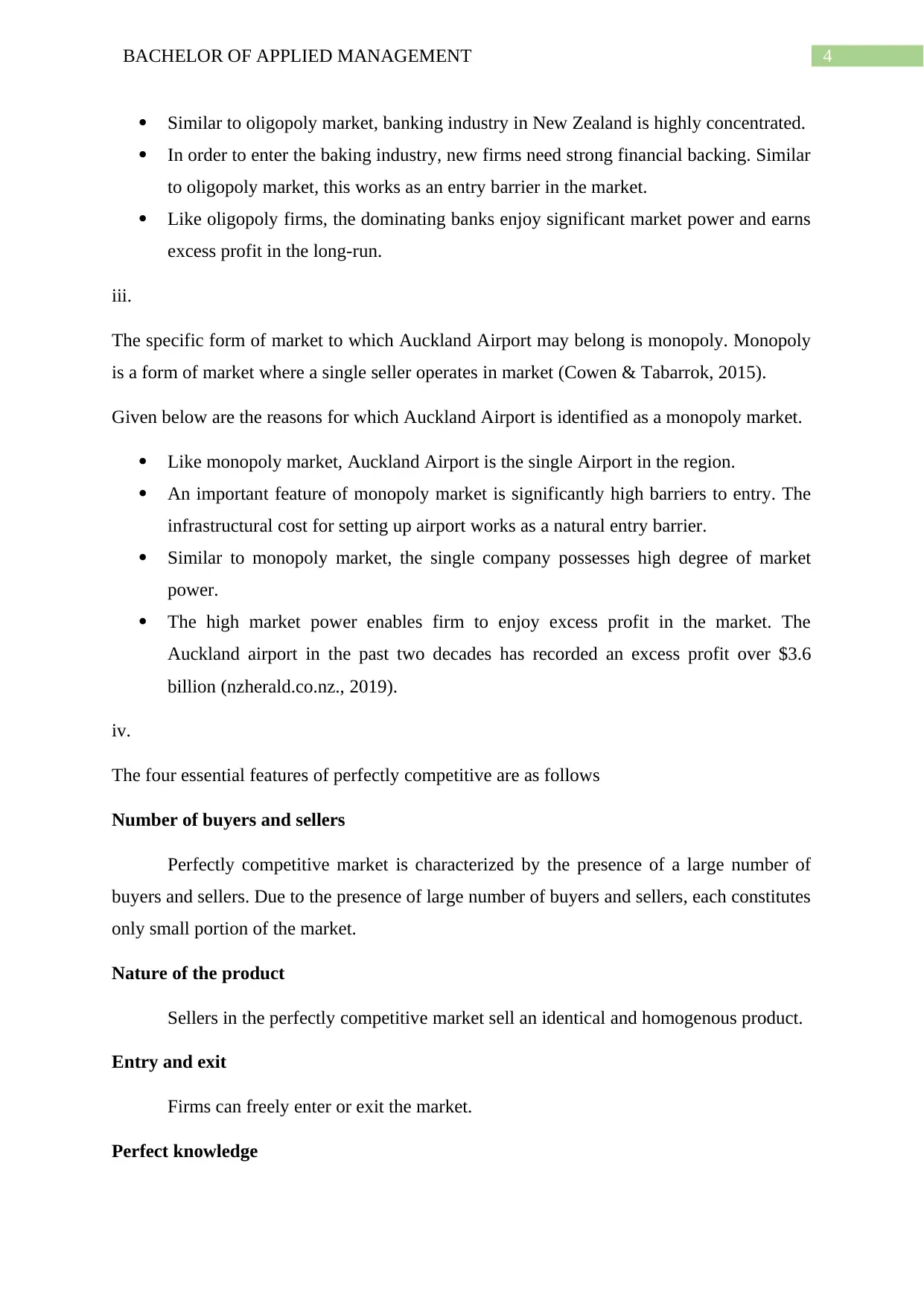
4BACHELOR OF APPLIED MANAGEMENT
Similar to oligopoly market, banking industry in New Zealand is highly concentrated.
In order to enter the baking industry, new firms need strong financial backing. Similar
to oligopoly market, this works as an entry barrier in the market.
Like oligopoly firms, the dominating banks enjoy significant market power and earns
excess profit in the long-run.
iii.
The specific form of market to which Auckland Airport may belong is monopoly. Monopoly
is a form of market where a single seller operates in market (Cowen & Tabarrok, 2015).
Given below are the reasons for which Auckland Airport is identified as a monopoly market.
Like monopoly market, Auckland Airport is the single Airport in the region.
An important feature of monopoly market is significantly high barriers to entry. The
infrastructural cost for setting up airport works as a natural entry barrier.
Similar to monopoly market, the single company possesses high degree of market
power.
The high market power enables firm to enjoy excess profit in the market. The
Auckland airport in the past two decades has recorded an excess profit over $3.6
billion (nzherald.co.nz., 2019).
iv.
The four essential features of perfectly competitive are as follows
Number of buyers and sellers
Perfectly competitive market is characterized by the presence of a large number of
buyers and sellers. Due to the presence of large number of buyers and sellers, each constitutes
only small portion of the market.
Nature of the product
Sellers in the perfectly competitive market sell an identical and homogenous product.
Entry and exit
Firms can freely enter or exit the market.
Perfect knowledge
Similar to oligopoly market, banking industry in New Zealand is highly concentrated.
In order to enter the baking industry, new firms need strong financial backing. Similar
to oligopoly market, this works as an entry barrier in the market.
Like oligopoly firms, the dominating banks enjoy significant market power and earns
excess profit in the long-run.
iii.
The specific form of market to which Auckland Airport may belong is monopoly. Monopoly
is a form of market where a single seller operates in market (Cowen & Tabarrok, 2015).
Given below are the reasons for which Auckland Airport is identified as a monopoly market.
Like monopoly market, Auckland Airport is the single Airport in the region.
An important feature of monopoly market is significantly high barriers to entry. The
infrastructural cost for setting up airport works as a natural entry barrier.
Similar to monopoly market, the single company possesses high degree of market
power.
The high market power enables firm to enjoy excess profit in the market. The
Auckland airport in the past two decades has recorded an excess profit over $3.6
billion (nzherald.co.nz., 2019).
iv.
The four essential features of perfectly competitive are as follows
Number of buyers and sellers
Perfectly competitive market is characterized by the presence of a large number of
buyers and sellers. Due to the presence of large number of buyers and sellers, each constitutes
only small portion of the market.
Nature of the product
Sellers in the perfectly competitive market sell an identical and homogenous product.
Entry and exit
Firms can freely enter or exit the market.
Perfect knowledge
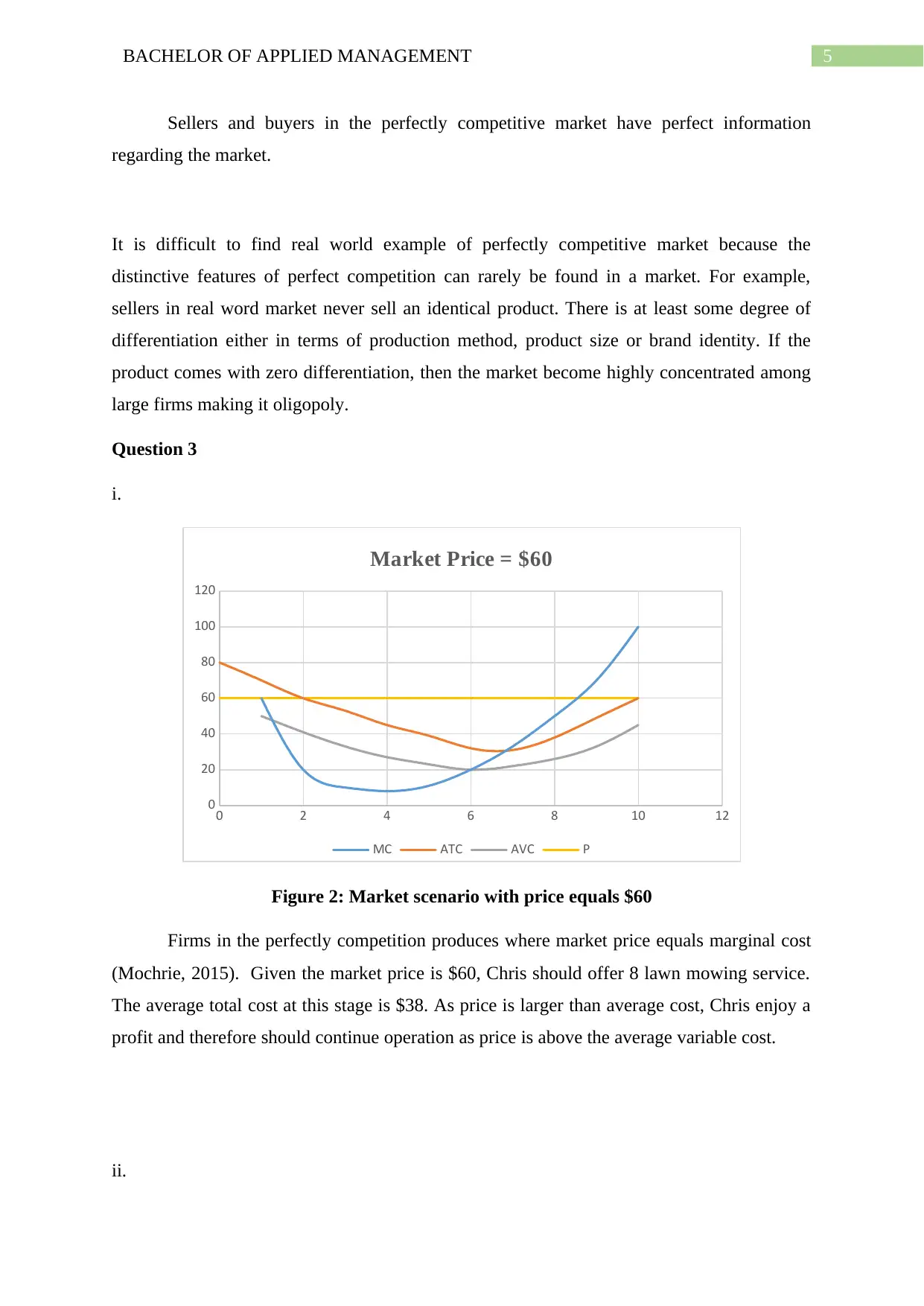
5BACHELOR OF APPLIED MANAGEMENT
Sellers and buyers in the perfectly competitive market have perfect information
regarding the market.
It is difficult to find real world example of perfectly competitive market because the
distinctive features of perfect competition can rarely be found in a market. For example,
sellers in real word market never sell an identical product. There is at least some degree of
differentiation either in terms of production method, product size or brand identity. If the
product comes with zero differentiation, then the market become highly concentrated among
large firms making it oligopoly.
Question 3
i.
0 2 4 6 8 10 12
0
20
40
60
80
100
120
Market Price = $60
MC ATC AVC P
Figure 2: Market scenario with price equals $60
Firms in the perfectly competition produces where market price equals marginal cost
(Mochrie, 2015). Given the market price is $60, Chris should offer 8 lawn mowing service.
The average total cost at this stage is $38. As price is larger than average cost, Chris enjoy a
profit and therefore should continue operation as price is above the average variable cost.
ii.
Sellers and buyers in the perfectly competitive market have perfect information
regarding the market.
It is difficult to find real world example of perfectly competitive market because the
distinctive features of perfect competition can rarely be found in a market. For example,
sellers in real word market never sell an identical product. There is at least some degree of
differentiation either in terms of production method, product size or brand identity. If the
product comes with zero differentiation, then the market become highly concentrated among
large firms making it oligopoly.
Question 3
i.
0 2 4 6 8 10 12
0
20
40
60
80
100
120
Market Price = $60
MC ATC AVC P
Figure 2: Market scenario with price equals $60
Firms in the perfectly competition produces where market price equals marginal cost
(Mochrie, 2015). Given the market price is $60, Chris should offer 8 lawn mowing service.
The average total cost at this stage is $38. As price is larger than average cost, Chris enjoy a
profit and therefore should continue operation as price is above the average variable cost.
ii.
⊘ This is a preview!⊘
Do you want full access?
Subscribe today to unlock all pages.

Trusted by 1+ million students worldwide

6BACHELOR OF APPLIED MANAGEMENT
0 2 4 6 8 10 12
0
20
40
60
80
100
120
Market Price = $30
MC ATC AVC P
Figure 3: Market scenario with price equals $30
At market price of $30, Chris should offer 6 lawn mowing services. As market price
is less than average total cost, Chris incurs a loss. Despite the loss, Chris should continue
operation as price is greater than average variable cost.
iii.
0 2 4 6 8 10 12
0
20
40
60
80
100
120
Market Price = $20
MC ATC AVC P
Figure 4: Market scenario with price equals $20
At market price = $20, marginal cost equals market price corresponding to 6 lawn
mowing service. The price equals minimum of average variable cost indicating shut down
point. Chris therefore should stop operation at this point.
0 2 4 6 8 10 12
0
20
40
60
80
100
120
Market Price = $30
MC ATC AVC P
Figure 3: Market scenario with price equals $30
At market price of $30, Chris should offer 6 lawn mowing services. As market price
is less than average total cost, Chris incurs a loss. Despite the loss, Chris should continue
operation as price is greater than average variable cost.
iii.
0 2 4 6 8 10 12
0
20
40
60
80
100
120
Market Price = $20
MC ATC AVC P
Figure 4: Market scenario with price equals $20
At market price = $20, marginal cost equals market price corresponding to 6 lawn
mowing service. The price equals minimum of average variable cost indicating shut down
point. Chris therefore should stop operation at this point.
Paraphrase This Document
Need a fresh take? Get an instant paraphrase of this document with our AI Paraphraser
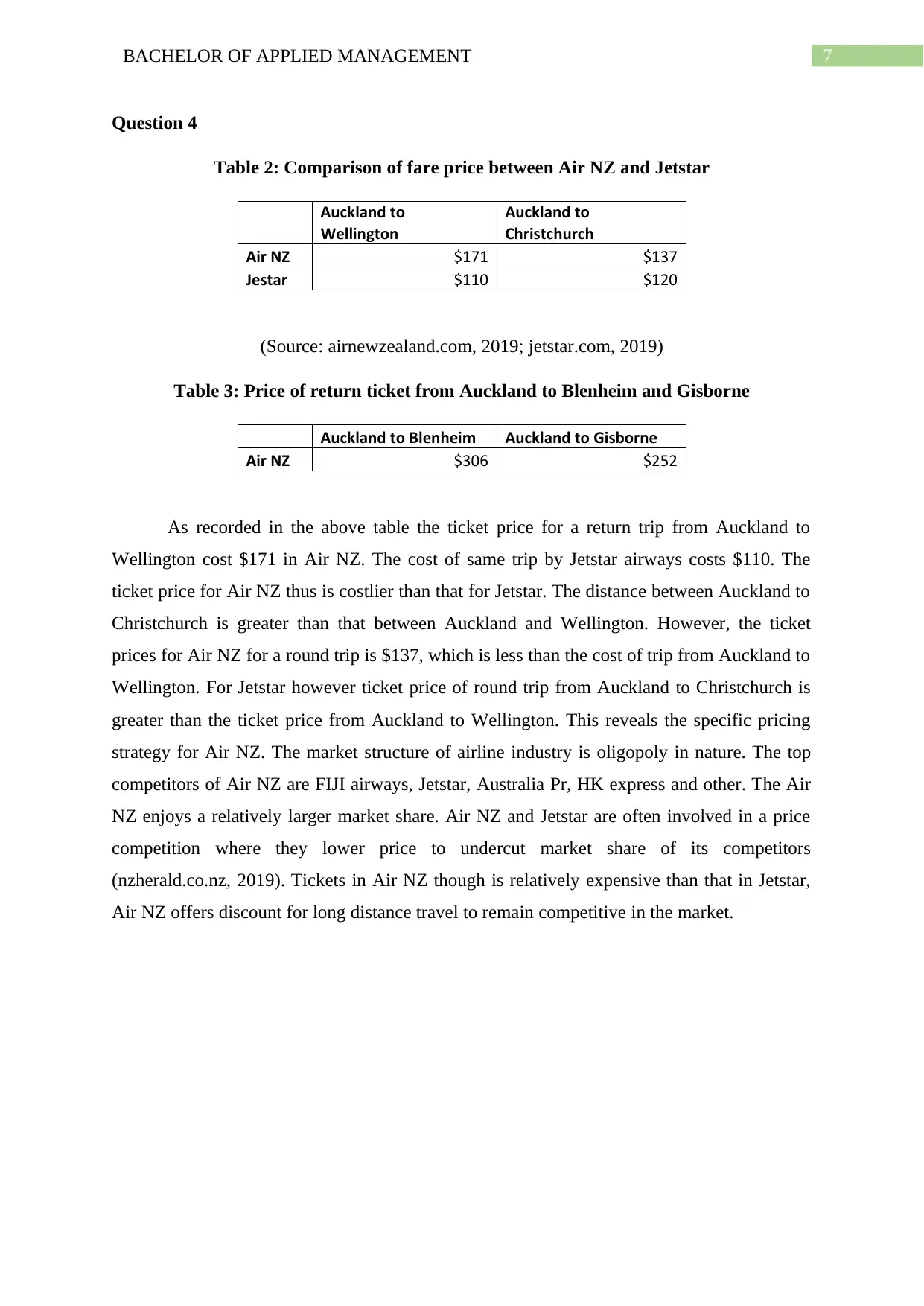
7BACHELOR OF APPLIED MANAGEMENT
Question 4
Table 2: Comparison of fare price between Air NZ and Jetstar
Auckland to
Wellington
Auckland to
Christchurch
Air NZ $171 $137
Jestar $110 $120
(Source: airnewzealand.com, 2019; jetstar.com, 2019)
Table 3: Price of return ticket from Auckland to Blenheim and Gisborne
Auckland to Blenheim Auckland to Gisborne
Air NZ $306 $252
As recorded in the above table the ticket price for a return trip from Auckland to
Wellington cost $171 in Air NZ. The cost of same trip by Jetstar airways costs $110. The
ticket price for Air NZ thus is costlier than that for Jetstar. The distance between Auckland to
Christchurch is greater than that between Auckland and Wellington. However, the ticket
prices for Air NZ for a round trip is $137, which is less than the cost of trip from Auckland to
Wellington. For Jetstar however ticket price of round trip from Auckland to Christchurch is
greater than the ticket price from Auckland to Wellington. This reveals the specific pricing
strategy for Air NZ. The market structure of airline industry is oligopoly in nature. The top
competitors of Air NZ are FIJI airways, Jetstar, Australia Pr, HK express and other. The Air
NZ enjoys a relatively larger market share. Air NZ and Jetstar are often involved in a price
competition where they lower price to undercut market share of its competitors
(nzherald.co.nz, 2019). Tickets in Air NZ though is relatively expensive than that in Jetstar,
Air NZ offers discount for long distance travel to remain competitive in the market.
Question 4
Table 2: Comparison of fare price between Air NZ and Jetstar
Auckland to
Wellington
Auckland to
Christchurch
Air NZ $171 $137
Jestar $110 $120
(Source: airnewzealand.com, 2019; jetstar.com, 2019)
Table 3: Price of return ticket from Auckland to Blenheim and Gisborne
Auckland to Blenheim Auckland to Gisborne
Air NZ $306 $252
As recorded in the above table the ticket price for a return trip from Auckland to
Wellington cost $171 in Air NZ. The cost of same trip by Jetstar airways costs $110. The
ticket price for Air NZ thus is costlier than that for Jetstar. The distance between Auckland to
Christchurch is greater than that between Auckland and Wellington. However, the ticket
prices for Air NZ for a round trip is $137, which is less than the cost of trip from Auckland to
Wellington. For Jetstar however ticket price of round trip from Auckland to Christchurch is
greater than the ticket price from Auckland to Wellington. This reveals the specific pricing
strategy for Air NZ. The market structure of airline industry is oligopoly in nature. The top
competitors of Air NZ are FIJI airways, Jetstar, Australia Pr, HK express and other. The Air
NZ enjoys a relatively larger market share. Air NZ and Jetstar are often involved in a price
competition where they lower price to undercut market share of its competitors
(nzherald.co.nz, 2019). Tickets in Air NZ though is relatively expensive than that in Jetstar,
Air NZ offers discount for long distance travel to remain competitive in the market.

8BACHELOR OF APPLIED MANAGEMENT
Section B: The role of Government in markets
Question 1
b.
Education is considered as a good that entails positive externality to the society. The
more educated a person is, the greater is the benefit to the society as educated people tend to
be more skilled, more enterprising implying a greater value to the community. The obtained
social benefit in the market thus is greater than the private benefit (Kolmar, 2017). As
individual do not consider the social benefit and they are concerned only with the private
benefit, they demand education less than the socially desirable quantity. The unregulated
market therefore produces a socially inefficient outcome leading to market failure.
Figure 5: Positive externality of education and market failure
As private market does not optimally produce and distribute education, government
needs to intervene in the market. Government either provides subsidy to encourage education
or offers education for free. In the latter case, education becomes a public good. With the
objective of increasing spread of tertiary education government of New Zealand introduced
new policies to make tertiary education more affordable (nzinitiative.org.nz, 2019). One such
policy includes making tertiary education free for the first year. Besides this, government has
also stopped charging interest on loans taken by the students. The policies aim to lower the
Section B: The role of Government in markets
Question 1
b.
Education is considered as a good that entails positive externality to the society. The
more educated a person is, the greater is the benefit to the society as educated people tend to
be more skilled, more enterprising implying a greater value to the community. The obtained
social benefit in the market thus is greater than the private benefit (Kolmar, 2017). As
individual do not consider the social benefit and they are concerned only with the private
benefit, they demand education less than the socially desirable quantity. The unregulated
market therefore produces a socially inefficient outcome leading to market failure.
Figure 5: Positive externality of education and market failure
As private market does not optimally produce and distribute education, government
needs to intervene in the market. Government either provides subsidy to encourage education
or offers education for free. In the latter case, education becomes a public good. With the
objective of increasing spread of tertiary education government of New Zealand introduced
new policies to make tertiary education more affordable (nzinitiative.org.nz, 2019). One such
policy includes making tertiary education free for the first year. Besides this, government has
also stopped charging interest on loans taken by the students. The policies aim to lower the
⊘ This is a preview!⊘
Do you want full access?
Subscribe today to unlock all pages.

Trusted by 1+ million students worldwide
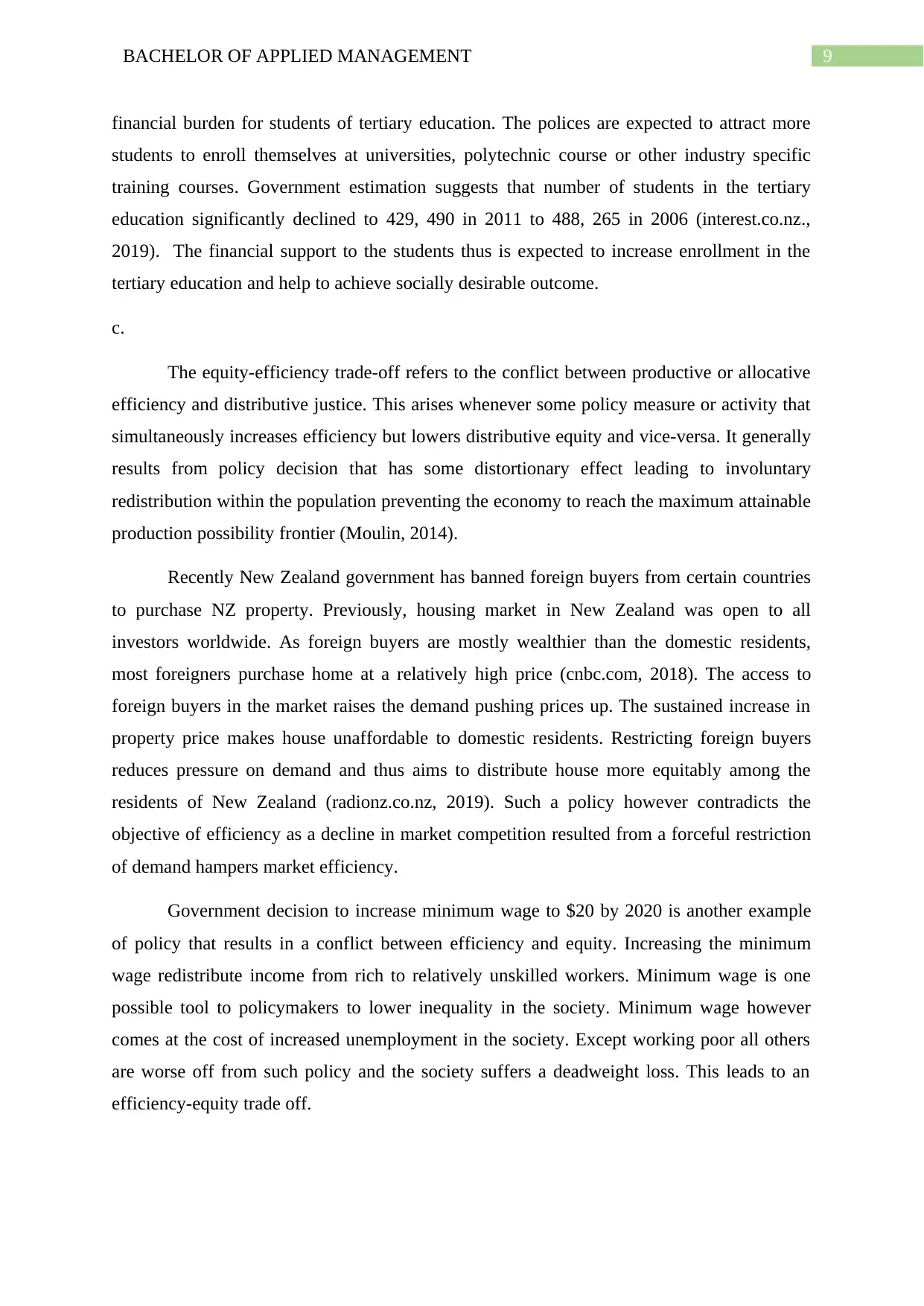
9BACHELOR OF APPLIED MANAGEMENT
financial burden for students of tertiary education. The polices are expected to attract more
students to enroll themselves at universities, polytechnic course or other industry specific
training courses. Government estimation suggests that number of students in the tertiary
education significantly declined to 429, 490 in 2011 to 488, 265 in 2006 (interest.co.nz.,
2019). The financial support to the students thus is expected to increase enrollment in the
tertiary education and help to achieve socially desirable outcome.
c.
The equity-efficiency trade-off refers to the conflict between productive or allocative
efficiency and distributive justice. This arises whenever some policy measure or activity that
simultaneously increases efficiency but lowers distributive equity and vice-versa. It generally
results from policy decision that has some distortionary effect leading to involuntary
redistribution within the population preventing the economy to reach the maximum attainable
production possibility frontier (Moulin, 2014).
Recently New Zealand government has banned foreign buyers from certain countries
to purchase NZ property. Previously, housing market in New Zealand was open to all
investors worldwide. As foreign buyers are mostly wealthier than the domestic residents,
most foreigners purchase home at a relatively high price (cnbc.com, 2018). The access to
foreign buyers in the market raises the demand pushing prices up. The sustained increase in
property price makes house unaffordable to domestic residents. Restricting foreign buyers
reduces pressure on demand and thus aims to distribute house more equitably among the
residents of New Zealand (radionz.co.nz, 2019). Such a policy however contradicts the
objective of efficiency as a decline in market competition resulted from a forceful restriction
of demand hampers market efficiency.
Government decision to increase minimum wage to $20 by 2020 is another example
of policy that results in a conflict between efficiency and equity. Increasing the minimum
wage redistribute income from rich to relatively unskilled workers. Minimum wage is one
possible tool to policymakers to lower inequality in the society. Minimum wage however
comes at the cost of increased unemployment in the society. Except working poor all others
are worse off from such policy and the society suffers a deadweight loss. This leads to an
efficiency-equity trade off.
financial burden for students of tertiary education. The polices are expected to attract more
students to enroll themselves at universities, polytechnic course or other industry specific
training courses. Government estimation suggests that number of students in the tertiary
education significantly declined to 429, 490 in 2011 to 488, 265 in 2006 (interest.co.nz.,
2019). The financial support to the students thus is expected to increase enrollment in the
tertiary education and help to achieve socially desirable outcome.
c.
The equity-efficiency trade-off refers to the conflict between productive or allocative
efficiency and distributive justice. This arises whenever some policy measure or activity that
simultaneously increases efficiency but lowers distributive equity and vice-versa. It generally
results from policy decision that has some distortionary effect leading to involuntary
redistribution within the population preventing the economy to reach the maximum attainable
production possibility frontier (Moulin, 2014).
Recently New Zealand government has banned foreign buyers from certain countries
to purchase NZ property. Previously, housing market in New Zealand was open to all
investors worldwide. As foreign buyers are mostly wealthier than the domestic residents,
most foreigners purchase home at a relatively high price (cnbc.com, 2018). The access to
foreign buyers in the market raises the demand pushing prices up. The sustained increase in
property price makes house unaffordable to domestic residents. Restricting foreign buyers
reduces pressure on demand and thus aims to distribute house more equitably among the
residents of New Zealand (radionz.co.nz, 2019). Such a policy however contradicts the
objective of efficiency as a decline in market competition resulted from a forceful restriction
of demand hampers market efficiency.
Government decision to increase minimum wage to $20 by 2020 is another example
of policy that results in a conflict between efficiency and equity. Increasing the minimum
wage redistribute income from rich to relatively unskilled workers. Minimum wage is one
possible tool to policymakers to lower inequality in the society. Minimum wage however
comes at the cost of increased unemployment in the society. Except working poor all others
are worse off from such policy and the society suffers a deadweight loss. This leads to an
efficiency-equity trade off.
Paraphrase This Document
Need a fresh take? Get an instant paraphrase of this document with our AI Paraphraser
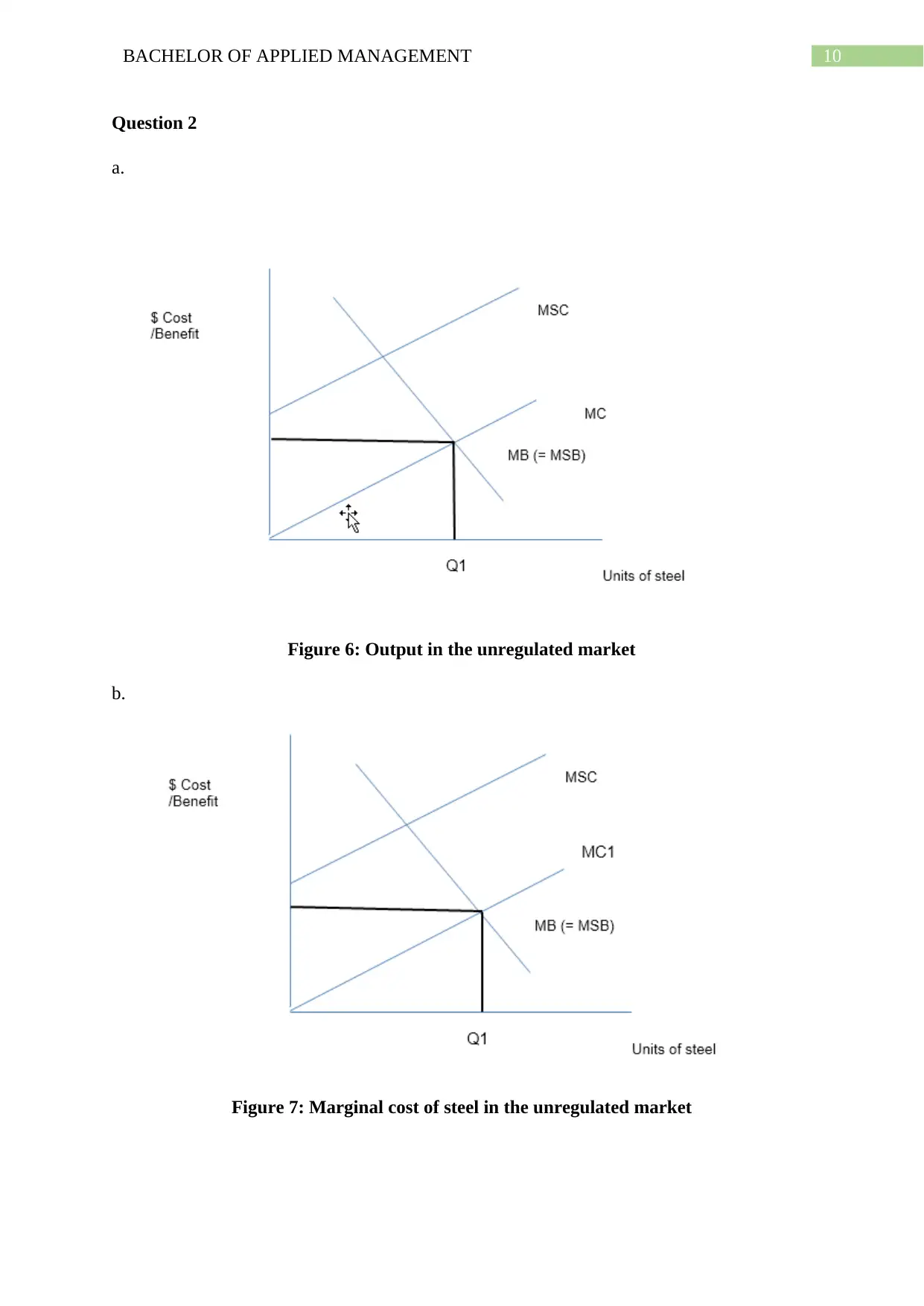
10BACHELOR OF APPLIED MANAGEMENT
Question 2
a.
Figure 6: Output in the unregulated market
b.
Figure 7: Marginal cost of steel in the unregulated market
Question 2
a.
Figure 6: Output in the unregulated market
b.
Figure 7: Marginal cost of steel in the unregulated market
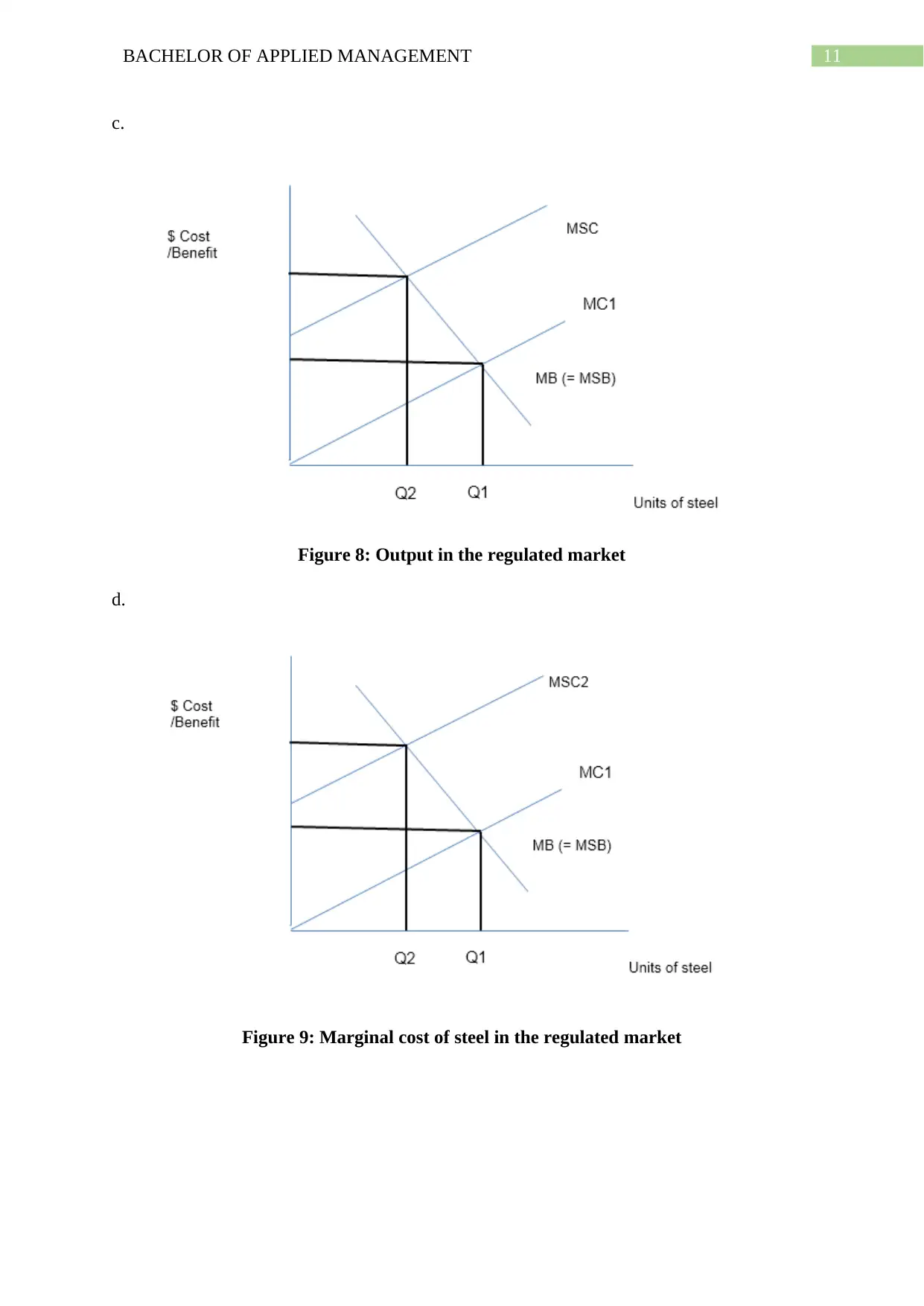
11BACHELOR OF APPLIED MANAGEMENT
c.
Figure 8: Output in the regulated market
d.
Figure 9: Marginal cost of steel in the regulated market
c.
Figure 8: Output in the regulated market
d.
Figure 9: Marginal cost of steel in the regulated market
⊘ This is a preview!⊘
Do you want full access?
Subscribe today to unlock all pages.

Trusted by 1+ million students worldwide
1 out of 15
Related Documents
Your All-in-One AI-Powered Toolkit for Academic Success.
+13062052269
info@desklib.com
Available 24*7 on WhatsApp / Email
![[object Object]](/_next/static/media/star-bottom.7253800d.svg)
Unlock your academic potential
Copyright © 2020–2025 A2Z Services. All Rights Reserved. Developed and managed by ZUCOL.





